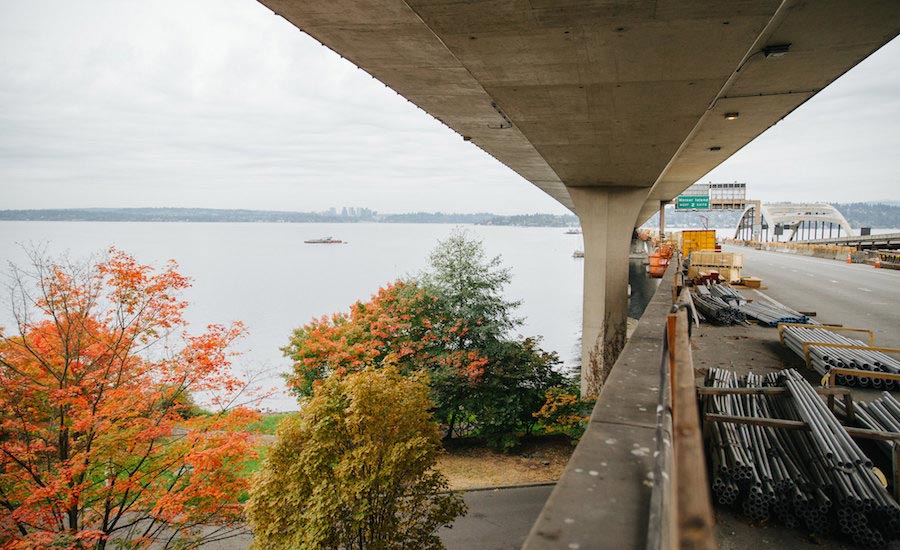Sound Transit’s Blue Line trains won’t travel across Interstate 90 from Seattle to Bellevue until 2023, but the effort to engineer how light rail will make the trip across a floating bridge — for the first time ever, anywhere — has been ongoing for years. And now crews are starting installation of that trickiest part of the endeavor, laying the “track bridges” to transition light rail vehicles onto the floating bridge.
The specialized track attachments will minimize weight and isolate stray current from the electric system that powers the trains. While the process of installing rail on the floating bridge has been underway for a year already, the planning and preparation was several years in the making before then. Last summer crews completed post-tensioning of the bridge pontoons, a process that reinforced the concrete and high-strength tensioned strands on the Homer M. Hadley floating bridge, the world’s second-longest floating bridge (the world’s largest is just a few miles away).
Almost 9,000 specially engineered and constructed lightweight concrete blocks are getting affixed to the bridge deck using a specialized epoxy called DexG. Rail gets set on the blocks, with steel tie bars placed between them to maintain gauge, similar to standard railroad tie systems. Features of the concrete blocks also isolate stray current that could damage bridge structures.
So far, crews have installed eight of these track bridges, specially engineered to compensate for six ranges of lake motion to enable trains to safely travel from the fixed sections of the bridge to the floating section. All of the track bridges are scheduled to be set into place by the end of 2019.
The I-90 bridge has a floating span of nearly 1 mile. That floating section — which can move up and down as much as 2 ft, move north and south based on wind, and even tilt because of traffic loads — connects to fixed bridges on either side. Getting a 300-ton light rail train across that accordion-style joint is no easy task. The concept includes a 43-ft curved platform that can move in such a way to keep the tracks safe, akin to a three-legged stool where the tracks rest on a platform that has pivoting bearings connected to a hinge. With an item sitting on three points you will always find a plane, no matter which direction the floating bridges rotate and push the hinge. The connections self-level to support the track at the joint in a continuous alignment.
The rail ties atop double pendulum bearings allow for motion under the platform while ensuring ties remained at a constant distance apart.
Sound Transit is simultaneously working to extend light rail north, south, east and west, opening new stations every few years to form a 116-mile regional system by 2041. The Northgate Link Extension adds three stations to the Red Line in 2021. In 2024, the Blue Line will extend from Overlake into downtown Redmond and additional extension will operate to Shoreline, Mountlake Terrace, Lynnwood, Kent/Des Moines and Federal Way. Further light rail extensions are scheduled to reach West Seattle, Fife and Tacoma in 2030, Ballard in 2035, Paine Field and Everett in 2036 and South Kirkland and Issaquah in 2041.
When the Blue Line opens in 2023, riders will travel from Mercer Island to the University of Washington in 20 minutes and from South Bellevue to Sea-Tac Airport in 50 minutes.
Follow Tim Newcomb on Twitter at @tdnewcomb.

